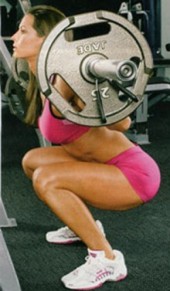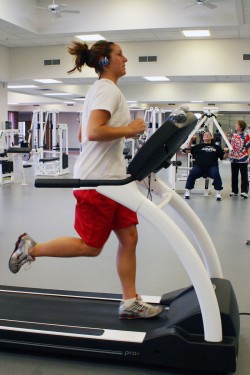Some Thoughts on Periodization
August 10, 2010 by danny · 7 Comments
The scary P word. I’ve known many people that would prefer to spend the entire day at the dentist rather than talk (or think about) periodization. Most people just want to go lift and turn their brain off for one hour, 3 to 4 days out of the week. To a certain point, I can see why this is the mind-set of many trainees. After all, you don’t have to look very hard to hear one trainer make a particular suggestion (no matter what the topic – reps, sets, form, tempo, etc), only to read 5 other trainers give 5 different opinions. Well, I’m here to help simplify.
I’m not going to get into a 12-month periodization plan that involves in-season, early off-season, general off-season, and pre-season planning. If you train athletes and are looking for a great resource, check out Eric Cressey’s, “The Ultimate Off-Season Training Manual.” This is a must for your coaching library!
For the purposes of this post however, I’m not going to be giving my thoughts on periodization for athletes (although some of this information can be useful if you are an athlete or train athletes). I’ll be speaking more to the trainee just looking to improve his or her health and physique.
-For the most part, you don’t need to plan more than a month in advance. Don’t get me wrong, I do think it is smart to look down the road for more than a month at what you are looking to accomplish. For example, I don’t recommend doing three straight blocks focusing on hypertrophy, then move on to a fat loss phase for a month, only to go right back into a hypertrophy phase. Just randomly throwing a fat loss block in there doesn’t really fit, and probably would hurt your chances to maximally put on muscle. But the bottom line, don’t sit on your butt for a month straight trying to figure out the perfect macrocycle when you could have been in the gym getting closer to your goals during that time.
-Psychology/motivation is huge! Yeah, full body (FB) training is great for fat loss. But let’s say that you just spent your last two training blocks (8 weeks total) training FB and you CAN’T STAND the thought of going into another FB block. After all, it can be very draining to know that you are going to be doing a deadlift or squat variation AT EVERY SINGLE session, EVERY SINGLE week. Even if a body part split may be less than perfect for fat loss purposes, it can be very motivating to know you are about to head to the gym, and NOT have to squat or deadlift. “Today’s back and biceps? Sweet, I can’t get to the gym soon enough!” Be sure to keep this in mind as you head into your next training block (or a block sometime down the line).
-I’ve tried just about every combination of fluctuating volume over the course of a training block (4 weeks). I’ve tried the Cressey Performance way (at least this is the way they typically set up a block the last time I checked), which is;
- Week 1 – High Volume
- Week 2 – Medium Volume
- Week 3 – Very High Volume
- Week 4 – Low Volume (Deload)
Then, there is a the Results Fitness way (again, last time I checked);
- Intro Week
- Base Week
- Overload Week
- Shock Week
Coach Alwyn Cosgrove sets it up so each week is harder than the next. Essentially, you build up each week so by the last week you are hitting your highest loads of the block and maybe setting some PR’s in the process. Then the next week you will start a new block, with the lowest volume (basically, your deload week).
There are other ways to set up this week-by-week fluctuation in volume/intensity. But right now, here is what I have been doing for some time now…
- Week 1 – Intro Week; Volume is lower than week 2 and 3 and I stay a little further from failure on this week. Basically, when bar speed is slower than rep 1, I stop the set. This isn’t set in stone, as I’m not really too scared about overtraining if I am doing some curls. So if I “grind” out a few reps on certain exercises, I’m cool with it. But I doubt you’ll see me doing multiple sets to failure with front squats, for example.
- Week 2 – Volume goes up and I may have a few more of the “grindy” reps than on week one. Still, I never go ’til I purposefully miss a rep
- Week 3 -Similar to week 2
- Week 4 – Deload week; volume is similar to week 1, maybe even a little lower (for the females, check out this article that I wrote awhile back – something to think about)
Justification
When I was doing the Cressey Performance set-up, I personally didn’t like to go into a high volume week when starting a new block. In week one of a new block, you are switching up exercises, sets, and reps. This greatly increases the chances of soreness. And then add to the fact that it is high volume week, I found this to be a recipe to have me limping around for days (especially on exercises that tend to make us sore anyway. i.e. RDLs). This is why I have since switched to week 1 being a low(er) volume week. I figure, I am going to be sore anyway on week 1, why make it even worse.
The Results Fitness way is great, but here I found I didn’t like the psychological aspect real well. By the time week 4 of the same program roles around, I’m actually getting a little bored. The last thing I want to do is make this my hardest week. A slight mental break, by going low(er) volume, is nice here. Plus, it helps to keep my feeling fresh going into the new block in the week to come.
For the above reasons, I’ve settled in on liking the approach that I am currently using. I am also a fan of “cybernetic periodization” (going by feel). So, if week 2 or 3 calls for 5 x 3, but I am feeling like superman, I may do 7 sets of 3 that week. On week’s 1 & 4 I try to fight this temptation as I don’t think my superman-like feeling would be worth it as it would negatively effect the week to come (risk:reward = not worth it). I must say however, that although I do like cybernetic periodization, I am not a big fan of just winging it (although on rare occasion this can be good psychologically… there’s that word again). I am fan of having a training template, but giving yourself a little freedom to adjust according to how you are feeling on that particular day.
I definitely do NOT think that the Cressey Performance and Results Fitness plans are wrong. You can probably look at ANY 4-week set-up and find something imperfect about it - including the model I am currently using. When I work with a client long enough, quite often I will have him/her try a few types of 4 week set-ups. I will go over the potential pros and cons with them, and get their thoughts after trying each plan. Together we then go with a plan that gets them the most fired up and motivated to train. Thus far, “my” current 4-week plan has been the most popular with my clients. This doesn’t necessarily mean anything, I’m just sayin’. ![]()
Finally, if you are reading this and are in your first year of serious lifting, you should look at most of the above as a bunch of mumbo-jumbo. BUT, I want you to save this, study it again after a year, and consider my thoughts as far as which training split to use (answer – use them all ![]() ), and which 4-week plan to go with. Remember, consider both physiological, and psychological factors. Happy planning!
), and which 4-week plan to go with. Remember, consider both physiological, and psychological factors. Happy planning!
Q & A: The Treadmill
June 7, 2010 by danny · Leave a Comment
Q: Danny, I have lost most of my weight by doing intervals on the treadmill. Since summer is here, I would rather run outside than go to the gym but I am worried the weight will come back because I will be sprinting on my own instead of on a treadmill…make sense? Should I be worried about that, or do you think I will be fine doing intervals outside?
A: I get this, should I run outside or on the treadmill question, quite a bit. While neither is necessarily wrong, I do prefer non-treadmill running. I’d much rather see you run outdoors (or indoors if it is on an indoor track, for example). And here’s why…
The treadmill switches your hams and glutes off. When your foot hits the treadmill, the belt pulls you through. So, the belt does much of the work for you as your leg goes back. Again, taking your hams and glutes out of play. This is a problem for a few reasons;
1) You burn less calories on a treadmill (as opposed to “real” running).
2) The contribution from the quads is still there, so this can lead to an imbalance which can lead to an injury (knees won’t like you). Awhile back I read an article that Strength CoachAlwyn Cosgrove contributed to, and here is what he wrote in regards to this imbalance;
“Walking a mile is about two thousand reps in the sagittal plane at about one and a half to two times your bodyweight. Jogging would be around fifteen hundred total reps at about two to three times your bodyweight.
And since the treadmill switches your hamstring and glutes off — your foot hits the belt and the belt pulls you through — it’s mainly a quad exercise.
So let’s say a client does three miles three times per week for one year (and I’m being conservative).
That’s 6000 reps x 3 days per week x 52 weeks, which equals 936,000 reps of knee extension work. Or 468,000 reps per leg.
Let’s say the load going through with the knee was a measly 100 pounds. That’s 4.6 million pounds of work for the quad with absolutely no hamstring work.
Think of it this way: if you did 400,000 reps of triceps extensions with 100 pounds you’d get four million pounds of volume. If you didn’t balance that out with biceps curls you’d expect the elbow joint to hurt, right? You’re damn straight it would!
So long term walking or running on the treadmill is almost guaranteeing knee pain. And that’s not even the worst part. Since the hamstring is switched off you’re actually burning even less calories than you would if you were to walk on the ground!”
3) The mechanics of running on the treadmill are not the same as “real” running as hip flexion angle increases (affecting the whole hip extensor mechanism) – this will lead to substitution patterns and even further increase your chances of injury (now your knees REALLY, REALLY, REALLY don’t like you).
The Winter
Growing up in Illinois, I know it would be a lot for me to ask you to go run outside when you looking at a negative 23 wind chill. Therefore, I won’t ask you do that (man, I’m too nice). You can get just as good of a cardio workout indoors, without ever stepping on a treadmill. For many people, I prefer “non-traditional” ways to get your cardio in, as I talked in this post. Below is an example from that previous post I made…
When it comes to crappy weather, no excuses! ![]()
If for whatever reason you love to run on the treadmill, I’m not saying that you should never step foot on it again. But for the above reasons, it would be wise for you to use sparingly. And in a perfect world, not use the t-mill at all. After all, who wants to burn less calories per session? Who want to increase their chances of injury (in the long term)? And who wants to jump on a machine that alters running mechanics, further increasing your chances of injury? Not I. One more thing; try to run on a good surface as much as possible. Something like “field turf,” a track, or some grass that is not too bumpy. These options are much easier on the joints than the hard streets and sidewalks. Enough typing, I’m going to go lift and lower heavy things, and then go find a nice hill to sprint up. Multiple times. Now that sounds like some fun, doesn’t it?!?
















